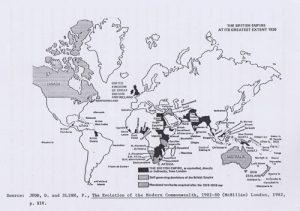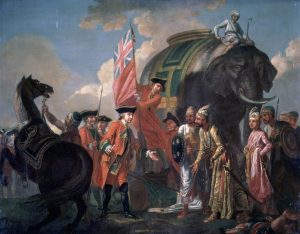American Anti-Colonialism, and the Liquidation of the British Empire.
Thus, it could be said that the peace-time distribution of the Royal Navy was based on the principle that in every sea was maintained a cruiser squadron, whose duty on the outbreak of war would be to defend British sea-borne trade in its area from sporadic attach. For example, by the mid-1930s there were “5 cruisers, 1 aircraft carrier, 1 minelayer, 5 sloops, 9 destroyers and 17 submarines on the China station. There were 3 cruisers and a number of sloops in the Indian Ocean; 2 cruisers and 4 sloops on the African station. There were 5 cruisers and 2 sloops on the American station with 4 destroyers of the Royal Canadian Navy. There were the New Zealand division of the Royal Navy (2 cruisers) with 2 sloops in New Zealand. And in Australia there was the Royal Australian Navy consisting of 4 cruisers (of which 1 was in reserve), 1 flotilla leader, 4 destroyers (2 in reserve), and 2 sloops.”7
Apart from all these dispersed squadrons there had to be the battle fleet prepared for operation in any one or more ports of the world. One half of this in the mid-1930s consisted of “5 battleships and 3 battle cruisers (some of which were normally under refit and so temporarily out of service), which were stationed in the home waters, to cover the areas in which the sea routes converge on the United Kingdom.”8 The distribution was partly dictated by the existence of two foreign fleets within a few hours steaming of those vital positions. The other half of the battle fleet consisting of “7 battleships (with the same proviso regarding absentees), was stationed in the Mediterranean, covering the first and perhaps the most vulnerable stage of imperial communications, which was also within striking distance of continental fleets.”9
The cost of maintaining this massive navy was nonetheless relatively cheap for many years. However, in the twentieth century, costs of ships especially began to escalate and it became more and more expensive to retain all these fleets (which we shall see in more detail below).
On the role of the British Army in protecting the Empire, it could be said that manpower was mostly provided by the individual countries of the Empire such as India. The United Kingdom supplied the machinery, which was transported by merchant ships under the protection of the Royal Navy.
By the end of the nineteenth century, defended essentially by her naval supremacy, Britain stood at the head of an empire with interests stretching right across the surface of the globe. Her commitments were similarly vast. She had built an economy, and a population which grew up within it, that relied for survival on the security of sea communications and on foreign trade. “As a great trading nation Britain came to lean upon a wide trading connection and, to an important extent, upon specialised services such as banking, insurance and shipping, and upon special skill in the production of finished articles, the raw material for which was imported from overseas.”10



